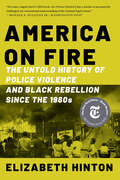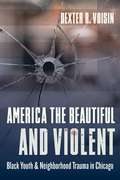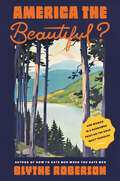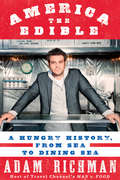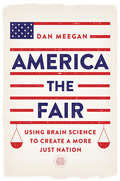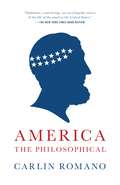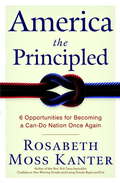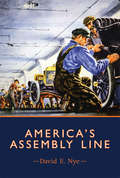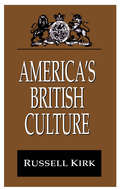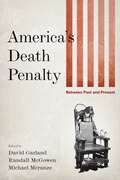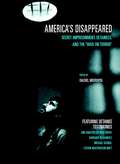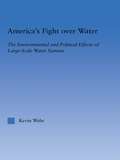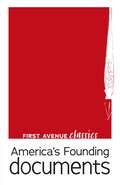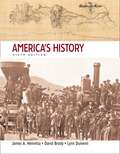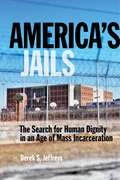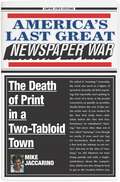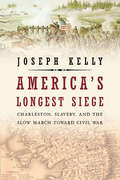- Table View
- List View
America in the Time of Martin Luther King Jr. (1948-1976)
by Sally Senzell IsaacsAmerica in the Time of is a series of nine books arranged chronologically, meaning that events are described in the order in which they happened. In each book, most articles deal with a particular event or part of American history. This book is about America from 1948 to 1976.
America in the Twenties: A History
by Geoffrey PerretEveryone knows the Twenties: flappers, jazz bands, the Charleston, teacups filled with bathtub gin-one long party and everyone had a hangover (known as the Depression) in the morning. The Twenties are both the most derided decade in American history and the most glamorous. It has been a pleasant experience to be told "How interesting" when people wanted to know what I was writing. They often elaborated with remarks such as "What a wonderfully decadent time!" or "That was the last time Americans really knew how to enjoy themselves." Almost without exception the hundred or more people who've asked me about this book had a firm, unshakable idea of what the period was like. I had begun with much the same idea myself. I thought of the Twenties as a period that had been "done"-to a turn.
America on Fire: The Untold History Of Police Violence And Black Rebellion Since The 1960s
by Elizabeth HintonFrom one of our top historians, a groundbreaking story of policing and “riots” that shatters our understanding of the post–civil rights era. <P><P> What began in spring 2020 as local protests in response to the killing of George Floyd by Minneapolis police quickly exploded into a massive nationwide movement. Millions of mostly young people defiantly flooded into the nation’s streets, demanding an end to police brutality and to the broader, systemic repression of Black people and other people of color. To many observers, the protests appeared to be without precedent in their scale and persistence. Yet, as the acclaimed historian Elizabeth Hinton demonstrates in America on Fire, the events of 2020 had clear precursors—and any attempt to understand our current crisis requires a reckoning with the recent past. <P><P>Even in the aftermath of Donald Trump, many Americans consider the decades since the civil rights movement in the mid-1960s as a story of progress toward greater inclusiveness and equality. Hinton’s sweeping narrative uncovers an altogether different history, taking us on a troubling journey from Detroit in 1967 and Miami in 1980 to Los Angeles in 1992 and beyond to chart the persistence of structural racism and one of its primary consequences, the so-called urban riot. Hinton offers a critical corrective: the word riot was nothing less than a racist trope applied to events that can only be properly understood as rebellions—explosions of collective resistance to an unequal and violent order. As she suggests, if rebellion and the conditions that precipitated it never disappeared, the optimistic story of a post–Jim Crow United States no longer holds. <P><P>Black rebellion, America on Fire powerfully illustrates, was born in response to poverty and exclusion, but most immediately in reaction to police violence. In 1968, President Lyndon Johnson launched the “War on Crime,” sending militarized police forces into impoverished Black neighborhoods. Facing increasing surveillance and brutality, residents threw rocks and Molotov cocktails at officers, plundered local businesses, and vandalized exploitative institutions. Hinton draws on exclusive sources to uncover a previously hidden geography of violence in smaller American cities, from York, Pennsylvania, to Cairo, Illinois, to Stockton, California. <P><P>The central lesson from these eruptions—that police violence invariably leads to community violence—continues to escape policymakers, who respond by further criminalizing entire groups instead of addressing underlying socioeconomic causes. The results are the hugely expanded policing and prison regimes that shape the lives of so many Americans today. Presenting a new framework for understanding our nation’s enduring strife, America on Fire is also a warning: rebellions will surely continue unless police are no longer called on to manage the consequences of dismal conditions beyond their control, and until an oppressive system is finally remade on the principles of justice and equality.
America the Beautiful and Violent: Black Youth and Neighborhood Trauma in Chicago
by Dexter VoisinWidespread media narratives portray an epidemic of neighborhood violence in urban areas—often ignoring the structural explanations advanced by community organizers fighting violence and activists such as those in the Movement for Black Lives. In this book, Dexter R. Voisin provides a compelling and social-justice-oriented analysis of current trends in neighborhood violence in light of the historical and structural factors that have reproduced entrenched patterns of racial and economic inequality. <P><P>America the Beautiful and Violent is built around the powerful voices and insights of black youth in Chicago and their parents and communities. Voisin interweaves their narratives with data, research findings, and historical accounts that provide context for their experiences. He highlights the broad historical, political, economic, and racial factors that shape the construction, concentration, and narratives of violence in black neighborhoods. Voisin explores these forces and the violence they produce; the behavioral health consequences of repeated exposures to neighborhood violence; and the ways youth, families, and communities cope with such traumas. America the Beautiful and Violent offers a set of practice and policy recommendations to address the patchwork inequality that leads to concentrated violence and to support children and adolescents struggling with the precarious conditions and threat of violence in their daily lives.
America the Beautiful?: One Woman in a Borrowed Prius on the Road Most Traveled
by Blythe RobersonThe author of How to Date Men When You Hate Men examines Americans’ obsession with freedom, travel, and the open road in this funny, entertaining travelogue that blends the humorous observations of Bill Bryson with the piercing cultural commentary of Jia Tolentino.For writer and comedian Blythe Roberson, there are only so many Mary Oliver poems you can read about being free, and only so many times you can listen to Joni Mitchell’s travel album Hejira, before you too, are itching to take off. Canonical American travel writers have long celebrated the road trip as the epitome of freedom. But why does it seem like all those canonical travel narratives are written by white men who have no problems, who only decide to go the desert to see what having problems feels like?To fill in the literary gaps and quench her own sense of adventure, Roberson quits her day job and sets off on a Great American Road Trip to visit America’s national parks.America the Beautiful? is a hilarious trip into the mind of one of the Millennial generation’s funniest writers. Borrowing her Midwestern stepfather’s Prius, she heads west to the Loop of mega-popular parks, over to the ocean and down the Pacific Coast Highway, and, in a feat of spectacularly bad timing, through the southwestern desert in the middle of July. Along the way she meets new friends on their own personal quests, learns to cope with abstinence while missing the comforts of home, and comes to understand the limits—and possibilities—of going to nature to prove to yourself and your Instagram followers that you are, in fact, free.The result is a laugh-out-loud-while-occasionally-raging-inside travelogue, filled with meditations and many, many jokes on ecotourism, conservation, freedom, traffic, climate change, and the structural and financial inequalities that limit so many Americans’ movement. Ultimately, Roberson ponders the question: Is quitting society and going on the road about enlightenment and liberty—or is it just selfish escapism?
America the Edible: A Hungry History, from Sea to Dining Sea
by Adam RichmanGet ready to devour America. Adam Richman, the exuberant host of Travel Channel's Man v. Food and Man v. Food Nation, has made it his business to root out unique dining experiences from coast to coast. Now, he zeroes in on some of his top-favorite cities—from Portland, Maine, to Savannah, Georgia—to share his uproariously entertaining food travel stories, top finds, and some invaluable (and hilarious) cautionary tales. America the Edible also tells the story behind the menu, revealing the little-known reason why San Francisco's sourdough bread couldn't exist without San Francisco's fog; why Cleveland just might have some of the country's best Asian cuisine; and how to eat like a native on the Hawaiian island of Oahu. Unflaggingly funny, curious, and, of course, hungry, Richman captures the spectacular melting pot of American cuisine as only a true foodie and insatiable storyteller can.
America the Fair: Using Brain Science to Create a More Just Nation
by Dan MeeganWhat makes a person liberal or conservative? Why does the Democratic Party scare off so many possible supporters? When does our "injustice trigger" get pulled, and how can fairness overcome our human need to look for a zero-sum outcome to our political battles?Tapping into a pop culture zeitgeist linking Bugs Bunny, Taylor Swift, and John Belushi; through popular science and the human brain; to our political predilections, arguments, and distrusts, Daniel Meegan suggests that fairness and equality are key elements missing in today's society. Having crossed the border to take up residency in Canada, Meegan, an American citizen, has seen first-hand how people enjoy as rights what Americans view as privileges. Fascinated with this tension, he suggests that American liberals are just missing the point. If progressives want to win the vote, they need to change strategy completely and champion government benefits for everyone, not just those of lower income. If everyone has access to inexpensive quality health care, open and extensive parental leave, and free postsecondary education, then everyone will be happier and society will be fair. The Left will also overcome an argument of the Right that successfully, though incongruously, appeals to the middle- and upper-middle classes: that policies that help the economically disadvantaged are inherently bad for others. Making society fair and equal, Meegan argues, would strengthen the moral and political position of the Democratic Party and place it in a position to revive American civic life. Fairness, he writes, should be selfishly enjoyed by everyone.
America the Philosophical
by Carlin RomanoA bold, insightful book that rejects the myth of America the Unphilosophical, arguing that America today towers as the most philosophical culture in the history of the world, an unprecedented marketplace of truth and argument that far surpasses ancient Greece or any other place one can name. With verve and keen intelligence, Carlin Romano--Pulitzer Prize finalist, award-winning book critic, and professor of philosophy--takes on the widely held belief that ours is an anti-intellectual society. Instead, while providing a richly reported overview of American thought, Romano argues that ordinary Americans see through phony philosophical justifications faster than anyone else, and that the best of our thinkers abandon artificial academic debates for fresh intellectual enterprises, such as cyberphilosophy. Along the way, Romano seeks to topple philosophy's most fiercely admired hero, Socrates, asserting that it is Isocrates, the nearly forgotten Greek philosopher who rejected certainty, whom Americans should honor as their intellectual ancestor. America the Philosophical introduces readers to a nation whose existence most still doubt: a dynamic, deeply stimulating network of people and places drawn together by shared excitement about ideas. From the annual conference of the American Philosophical Association, where scholars tack wiseguy notes addressed to Spinoza on a public bulletin board, to the eruption of philosophy blogs where participants discuss everything from pedagogy to the philosophy of science to the nature of agency and free will, Romano reveals a world where public debate and intellectual engagement never stop. And readers meet the men and women whose ideas have helped shape American life over the previous few centuries, from well-known historical figures like William James and Ralph Waldo Emerson, to modern cultural critics who deserve to be seen as thinkers (Kenneth Burke, Edward Said), to the iconoclastic African American, women, Native American, and gay mavericks (Cornel West, Susan Sontag, Anne Waters, Richard Mohr) who have broadened the boundaries of American philosophy. Smart and provocative, America the Philosophical is a rebellious tour de force that both celebrates our country's unparalleled intellectual energy and promises to bury some of our most hidebound cultural clichés.
America the Principled
by Rosabeth Moss KanterKanter details six ways to restore America's strengths by returning to open-society principles, viewing this society as one that "invests in people and new ideas, rewards talent and hard work, values dialogue and learns from dissent, operates to high standards with transparent information, looks for common ground, sees problems as opportunities for creative change, and encourages those who are fortunate to help others. " She discusses how America needs to spread innovation and the opportunity to participate in the economic revolution of the twenty-first century, and have a new social contract based on real family values and fair and flexible workplaces attentive to families and women. She also argues for values-based capitalism and responsible companies, government as an instrument of public interest, engagement with the world and other countries, and a community of caring. Kanter (strategy, innovation, and leadership for change, Harvard Business School) has advised CEOs of large and small companies and is the author of several books. Annotation ©2008 Book News, Inc. , Portland, OR (booknews. com)
America's Asia: Racial Form and American Literature, 1893-1945
by Colleen LyeWhat explains the perception of Asians both as economic exemplars and as threats? America's Asia explores a discursive tradition that affiliates the East with modern efficiency, in contrast to more familiar primitivist forms of Orientalism. Colleen Lye traces the American stereotype of Asians as a "model minority" or a "yellow peril"--two aspects of what she calls "Asiatic racial form"-- to emergent responses to globalization beginning in California in the late nineteenth century, when industrialization proceeded in tandem with the nation's neocolonial expansion beyond its continental frontier. From Progressive efforts to regulate corporate monopoly to New Deal contentions with the crisis of the Great Depression, a particular racial mode of social redress explains why turn-of-the-century radicals and reformers united around Asian exclusion and why Japanese American internment during World War II was a liberal initiative. In Lye's reconstructed archive of Asian American racialization, literary naturalism and its conventions of representing capitalist abstraction provide key historiographical evidence. Arguing for the profound influence of literature on policymaking, America's Asia examines the relationship between Jack London and leading Progressive George Kennan on U.S.-Japan relations, Frank Norris and AFL leader Samuel Gompers on cheap immigrant labor, Pearl S. Buck and journalist Edgar Snow on the Popular Front in China, and John Steinbeck and left intellectual Carey McWilliams on Japanese American internment. Lye's materialist approach to the construction of race succeeds in locating racialization as part of a wider ideological pattern and in distinguishing between its different, and sometimes opposing, historical effects.
America's Assembly Line
by David E. NyeFrom the Model T to today's "lean manufacturing": the assembly line as crucial, yet controversial, agent of social and economic transformation.The mechanized assembly line was invented in 1913 and has been in continuous operation ever since. It is the most familiar form of mass production. Both praised as a boon to workers and condemned for exploiting them, it has been celebrated and satirized. (We can still picture Chaplin's little tramp trying to keep up with a factory conveyor belt.) In America's Assembly Line, David Nye examines the industrial innovation that made the United States productive and wealthy in the twentieth century.The assembly line—developed at the Ford Motor Company in 1913 for the mass production of Model Ts—first created and then served an expanding mass market. It also transformed industrial labor. By 1980, Japan had reinvented the assembly line as a system of “lean manufacturing”; American industry reluctantly adopted the new approach. Nye describes this evolution and the new global landscape of increasingly automated factories, with fewer industrial jobs in America and questionable working conditions in developing countries. A century after Ford's pioneering innovation, the assembly line continues to evolve toward more sustainable manufacturing.
America's British Culture (The\library Of Conservative Thought Ser.)
by Russell KirkIt is an incontestable fact of history that the United States, although a multiethnic nation, derives its language, mores, political purposes, and institutions from Great Britain. The two nations share a common history, religious heritage, pattern of law and politics, and a body of great literature. Yet, America cannot be wholly confident that this heritage will endure forever. Declining standards in education and the strident claims of multiculturalists threaten to sever the vital Anglo-American link that ensures cultural order and continuity. In "America's British Culture", now in paperback, Russell Kirk offers a brilliant summary account and spirited defense of the culture that the people of the United States have inherited from Great Britain. Kirk discerns four essential areas of influence. The language and literature of England carried with it a tradition of liberty and order as well as certain assumptions about the human condition and ethical conduct. American common and positive law, being derived from English law, gives fuller protection to the individual than does the legal system of any other country. The American form of representative government is patterned on the English parliamentary system. Finally, there is the body of mores - moral habits, beliefs, conventions, customs - that compose an ethical heritage. Elegantly written and deeply learned, "America's British Culture" is an insightful inquiry into history and a plea for cultural renewal and continuity. Adam De Vore in "The Michigan Review" said of the book: "A compact but stimulating tract...a contribution to an over-due cultural renewal and reinvigoration...Kirk evinces an increasingly uncommon reverence for historical accuracy, academic integrity and the understanding of one's cultural heritage," and Merrie Cave in "The Salisbury Review" said of the author: "Russell Kirk has been one of the most important influences in the revival of American conservatism since the fifties. [Kirk] belongs to an
America's Cultural Revolution: How the Radical Left Conquered Everything
by Christopher F. RufoAN INSTANT NEW YORK TIMES, USA TODAY, AND AMAZON BESTSELLER America’s most effective conservative intellectual proves once and for all that Marxist radicals have taken over our nation's institutions.In the 1960s, Mao launched China’s Cultural Revolution. Cities grew overcrowded. Technocrats demanded progress from above. Anyone opposed was sent to be “re-educated.” China’s revolution was bloody, fast, and a failure, but what if America started a revolution at the same time, based on the same bad ideas, and it’s just been slower, calmer, and more effective?In his powerful new book, Christopher F. Rufo uncovers the hidden history of left-wing intellectuals and activists who systematically took control of America’s institutions to undermine them from within. America’s Cultural Revolution finally answers so many of the questions normal Americans have, such as:• Why is nearly every major corporation bending the knee to a far-left agenda?• How did DEI suddenly become the department no institution can continue without?• Why is race the main thing America’s rich, white elite wants to talk about? • When did the left adopt all this doublespeak, saying progress is a lack of progress, equality is not equality, speech is violence, and violence is speech?• Has the goal of the left, for a century, actually been the destruction of every Western institution? Readers may not know the names of Herbert Marcuse, Angela Davis, Paulo Freire, and Derrick Bell, but they will recognize the ideas they spread. How their radical, destructive ideology slowly worked its way from prisons to academia to classrooms to your human resources department will come as a shock.Failing to act soon, Rufo warns, could allow the radical left to achieve their ultimate objective: replacing constitutional equality with a race-based redistribution system overseen by bureaucratic ‘diversity and inclusion’ officials. Most Americans don’t want this, but most Americans are no longer in control of our institutions. If the mainstream media’s depiction of a failing dystopia in need of a fresh start never sounded right to you, this expose and call to arms is the book you’ve been looking for.
America's Death Penalty: Between Past and Present
by David Garland Michael Meranze Randall McGowenOver the past three decades, the United States has embraced the death penalty with tenacious enthusiasm. While most of those countries whose legal systems and cultures are normally compared to the United States have abolished capital punishment, the United States continues to employ this ultimate tool of punishment. The death penalty has achieved an unparalleled prominence in our public life and left an indelible imprint on our politics and culture. It has also provoked intense scholarly debate, much of it devoted to explaining the roots of American exceptionalism.America’s Death Penalty takes a different approach to the issue by examining the historical and theoretical assumptions that have underpinned the discussion of capital punishment in the United States today. At various times the death penalty has been portrayed as an anachronism, an inheritance, or an innovation, with little reflection on the consequences that flow from the choice of words. This volume represents an effort to restore the sense of capital punishment as a question caught up in history. Edited by leading scholars of crime and justice, these original essays pursue different strategies for unsettling the usual terms of the debate. In particular, the authors use comparative and historical investigations of both Europe and America in order to cast fresh light on familiar questions about the meaning of capital punishment. This volume is essential reading for understanding the death penalty in America.Contributors: David Garland, Douglas Hay, Randall McGowen, Michael Meranze, Rebecca McLennan, and Jonathan Simon.
America's Digital Army: Games at Work and War (Anthropology of Contemporary North America)
by Robertson AllenAmerica’s Digital Army is an ethnographic study of the link between interactive entertainment and military power, drawing on Robertson Allen’s fieldwork observing video game developers, military strategists, U.S. Army marketing agencies, and an array of defense contracting companies that worked to produce the official U.S. Army video game, America’s Army. Allen uncovers the methods by which gaming technologies such as America’s Army, with military funding and themes, engage in a militarization of American society that constructs everyone, even nonplayers of games, as virtual soldiers available for deployment.America’s Digital Army examines the army’s desire for “talented” soldiers capable of high-tech work; beliefs about America’s enemies as reflected in the game’s virtual combatants; tensions over best practices in military recruiting; and the sometimes overlapping cultures of gamers, game developers, and soldiers. Allen reveals how binary categorizations such as soldier versus civilian, war versus game, work versus play, and virtual versus real become blurred—if not broken down entirely—through games and interactive media that reflect the U.S. military’s ludic imagination of future wars, enemies, and soldiers.
America's Disappeared: Secret Imprisonment, Detainees, and the War on Terror (Open Media Series)
by Barbara Olshansky Steven Macpherson Watt Reed Brody Rachel Meeropol Michael RatnerThe confirmation proceedings for Alberto R. Gonzales and Condeleezza Rice, like the Abu Ghraib prison scandal, triggered a national debate about the U.S. government's controversial treatment of detainees and its practice of torture. At the heart of the debate is the question: Is the United States undermining democracy, freedom, and human rights in it's effort to protect its citizens from terrorism? The authors of AMERICA'S DISAPPEARED answer, yes.AMERICA'S DISAPPEARED describes how the U.S. government, in response to the events of 9/11, launched an unprecedented campaign of racial profiling, detentions, and deportations so grievous as to evoke the internment of Japanese Americans during World War II. It brings together, for the first time, detainees' own testimonies along with analysis by the leading constitutional attorneys and human rights advocates. In addition to a detailed exploration of detention--the forms currently in use, and the conditions of each--the book challenges the Bush administration's justifications for violating the Geneva Conventions and the most basic definitions of human rights.
America's Fight Over Water: The Environmental and Political Effects of Large-Scale Water Systems (Studies in American Popular History and Culture)
by Kevin WehrThis book inquires into the relations between society and its natural environment by examining the historical discourse around several cases of state building in the American West: the construction of three high dams from 1928 to 1963.
America's First Female Serial Killer: Jane Toppan and the Making of a Monster
by Mary Kay McBrayerThis is Capote’s In Cold Blood for serial killer enthusiasts: meticulously researched, superbly written, and incredibly vivid. Don’t miss it.” —Gabino Iglesias, author of Coyote SongsAmerica’s First Female Serial Killer novelizes the true story of first-generation Irish-American nurse Jane Toppan, born as Honora Kelley. Although all the facts are intact, books about her life and her crimes are all facts and no story. Jane Toppan was absolutely a monster, but she did not start out that way.When Jane was a young child, her father abandoned her and her sister to the Boston Female Asylum. From there, Jane was indentured to a wealthy family who changed her name, never adopted her, wrote her out of the will, and essentially taught her how to hate herself. Jilted at the altar, Jane became a nurse and took control of her life—and the lives of her victims.“A thoughtful and inspired take on one of the greatest poisoners in history. America’s First Female Serial Killer: Jane Toppan and the Making of a Monster seethes with rage, compulsion, and a righteous condemnation of the servitude of the underclass. A chilling and sobering read.” —Robert Levy, author of The Glittering World“McBrayer offers us a complex—and terrifying—portrait of a killer who seemed almost doomed from birth.” —Kate Winkler Dawson, author of American Sherlock: Murder, Forensics, and the Birth of American CSI“Brings the horrifying true story of Jane Toppan to lurid, novelistic life, and forces the reader face-to-face with the thoughtlessness and cruelty that helped turn a gifted, damaged child into one of America’s most legendary killers.” —Shaun Hamill, author of A Cosmology of Monsters
America's Founding Documents: The Declaration of Independence, the Articles of Confederation, the United States Constitution, the Federalist Papers, and the Bill of Rights (First Avenue Classics ™)
by Alexander Hamilton James Madison John Jay Thomas JeffersonSoon after the start of the American Revolutionary War in 1775, the Thirteen Colonies proclaimed their independence from British rule and became the United States of America. The written word proved vital in shaping America's new identity, laying the groundwork for societal principles and political doctrine alike. From Thomas Jefferson and the members of the Second Continental Congress, to Alexander Hamilton, James Madison, and John Jay, the authors of these documents had a profound and lasting effect on United States history. This collection includes unabridged versions of five famous and influential documents that helped to found a nation: the Declaration of Independence (1776), the Articles of Confederation (1777), the United States Constitution (1787), the Federalist Papers (1787–1788), and the Bill of Rights (1791).
America's Got Democracy!: The Making of the World's Longest-Running Reality Show
by Danny KatchA humorous but passionate look at the criminal silliness of the US political system from the author who has &“better comic bomb sights than John Stewart&” (Mike Davis, author of The Monster at Our Door). In this raucous, irreverent book, Danny Katch diagnoses the various mental disorders peculiar to those who have way too much money and power—and the politicians who work for them. He shows how the very elections that are supposed to be our way of bringing about change have become a tool to get us to accept the insane status quo. &“The funniest, smartest, and most dangerous political writer you never heard of is Danny Katch. You&’ll laugh. You&’ll get pissed off. You&’ll disagree. And you&’ll wonder how you read this terrific book in one sitting. A welcome antidote to what passes for political writing in an election year.&” —Dave Zirin, author of Game Over: How Politics Has Turned the Sports World Upside Down &“From Cocoa Puffs to melting ice caps, Danny Katch&’s America&’s Got Democracy gets to the heart of how and why our political establishment creates economic, social, and environmental crapification, and he does it with a flair even the most disaffected café barista with a PhD will love. But if you enjoy reading dry, abstract political works in which the words go clopping across the page on little wooden feet, don&’t read Katch&’s book.&” —Sherry Wolf, author of Sexuality and Socialism &“Guess what? It&’s even more boringer reading it than talking about it.&” —Lila Katch, seven years old
America's History
by James A. Henretta Lynn Dumenil David BrodyIn order for students to succeed in an AP U. S. history course, they need to understand not only what happened, but also why it happened. "America's History" has long been praised as a text that helps students to think critically about history and analyze both how and why historical events have occurred. "America's History" deftly weaves together political, social, and cultural history in a narrative that students find accessible and engaging. Exceptional pedagogical support -- overviews, maps, figures, illustrations, and embedded documents -- are carefully integrated to encourage the development of students' historical skills. "America's History" is the text that covers not only the facts, but also the skills that students need to have success in the AP U. S. history course. Need help with the audit? Click here to download an AP correlation.
America's History, Sixth Edition
by James A. Henretta Lynn Dumenil David BrodyHigh School AP U.S. history textbook
America's Jails: The Search for Human Dignity in an Age of Mass Incarceration (Alternative Criminology #8)
by Derek JeffreysA look at the contemporary crisis in U.S. jails with recommendations for improving and protecting the dignity of inmates Twelve million Americans go through the U.S. jail system on an annual basis. Jails, which differ significantly from prisons, are designed to house inmates for short amounts of time, and are often occupied by large populations of legally innocent people waiting for a trial. Jails often have deplorable sanitary conditions, and there are countless records of inmates being brutalized by staff and other inmates while in custody. Local municipalities use jails to institutionalize those whom they perceive to be a threat, so hundreds of thousands of inmates suffer from mental illness. People abandoned by families or lacking health insurance, or those who cannot afford bail, often cycle in and out of jails. In America’s Jails, Derek Jeffreys draws on sociology, philosophy, history, and his personal experience volunteering in jails and prisons to provide an understanding of the jail experience from the inmates’ perspective, focusing on the stigma that surrounds incarceration. Using his research at Cook County Jail, the nation’s largest single-site jail, Jeffreys attests that jail inmates possess an inherent dignity that should govern how we treat them. Ultimately, fundamental changes in the U.S. jail system are necessary and America’s Jails provides specific policy recommendations for changing its poor conditions. Highlighting the experiences of inmates themselves, America’s Jails aims to shift public perception and understanding of jail inmates to center their inherent dignity and help eliminate the stigma attached to their incarceration.
America's Last Great Newspaper War: The Death of Print in a Two-Tabloid Town
by Mike JaccarinoNAMED A BEST BOOK OF THE WEEK BY THE NEW YORK POSTALSO AVAILABLE AS AN AUDIOBOOKA from-the-trenches view of New York Daily News and New York Post runners and photographers as they stop at nothing to break the story and squash their tabloid arch-rivals.When author Mike Jaccarino was offered a job at the Daily News in 2006, he was asked a single question: “Kid, what are you going to do to help us beat the Post?” That was the year things went sideways at the News, when the New York Post surpassed its nemesis in circulation for the first time in the history of both papers. Tasked with one job—crush the Post—Jaccarino here provides the behind-the-scenes story of how the runners and shooters on both sides would do anything and everything to get the scoop before their opponents.The New York Daily News and the New York Post have long been the Hatfields and McCoys of American media: two warring tabloids in a town big enough for only one of them. As digital news rendered print journalism obsolete, the fight to survive in NYC became an epic, Darwinian battle. In America’s Last Great Newspaper War, Jaccarino exposes the untold story of this tabloid death match of such ferocity and obsession its like has not occurred since Pulitzer– Hearst.Told through the eyes of hungry “runners” (field reporters) and “shooters” (photographers) who would employ phony police lights to overcome traffic, Mike Jaccarino’s memoir unmasks the do-whatever-it-takes era of reporting—where the ends justified the means and nothing was off-limits. His no-holds-barred account describes sneaking into hospitals, months-long stakeouts, infiltrating John Gotti’s crypt, bidding wars for scoops, high-speed car chases with Hillary Clinton, O.J. Simpson, and the baby mama of a philandering congressman—all to get that coveted front-page story.Today, few runners and shooters remain on the street. Their age and exploits are as bygone as the News–Post war and American newspapers, generally. Where armies once battled, often no one is covering the story at all.Funding for this book was provided by: Furthermore: a program of the J. M. Kaplan Fund
America's Longest Siege: Charleston, Slavery, and the Slow March Toward Civil War
by Joseph Kelly“[A] vivid and engrossing study of slavery in and around one of its trading hubs, Charleston, SC . . . an important contribution to Southern antebellum history.” —Library JournalIn America’s Longest Siege, historian Joseph Kelly captures the toxic mix of nationalism, paternalism, and wealth that made Charleston the center of the nationwide debate over slavery and the tragic act of secession that doomed both the city and the South. Thoroughly researched and compulsively readable, America’s Longest Siege offers a new take on the Civil War and the culture that made it inevitable.“Lays bare the decades-long campaign of rationalization and intimidation that revivified and reinforced the institution of slavery and dragged the United States into disunion and civil war . . . this masterful study is a timely and important reminder of the consequences that result when ideological extremists succeed in drowning out the voices of reason.” —Peter Quinn, author of Hour of the Cat

